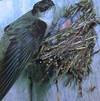Genus Chaetura
Short-tailed swift - The Short-tailed Swift is about 10.5 cm long, and weighs 20 g. It has long narrow wings, a robust body and a short tail. The sexes are similar. It is mainly black with a pale rump and tail. It can be distinguished from related species in its range, such as the Band-rumped Swift or the Gray-rumped Swift by the lack of contrast between the rump and the tail, the latter being much darker in the other species.
Chapman's Swift - The Chapman's Swift is a species of swift in the Apodidae family. It is found in Brazil, Colombia, French Guiana, Guyana, Panama, Suriname, Trinidad and Tobago, and Venezuela. Its natural habitats are subtropical or tropical moist lowland forests and heavily degraded former forest.
Gray-rumped Swift - This species breeds in hill forests from Nicaragua south to Peru, Brazil and northern Argentina, and Grenada, Trinidad and Tobago. The nest is a half saucer of twigs glued to the inside of a tree hole, chimney or similar shaded location with saliva.
Pale-rumped Swift - The Pale-rumped Swift is a species of swift in the Apodidae family. It is found in Bolivia, Brazil, Ecuador, and Peru. Its natural habitat is subtropical or tropical moist lowland forests.
Costa Rican Swift - The Costa Rican Swift is a species of swift in the Apodidae family. It is found in Colombia, Costa Rica, and Panama. Its natural habitat is subtropical or tropical moist lowland forests.
Lesser Antillean Swift - The Lesser Antillean Swift is a species of swift in the Apodidae family. It breeds on Dominica, Guadeloupe, Martinique, Saint Lucia and Saint Vincent. There is a possible record from Nevis. Its natural habitats are subtropical or tropical moist lowland forests and heavily degraded former forest.
Sick's swift - It breeds in south-eastern Brazil and adjacent parts of Argentina, Paraguay and Bolivia, but is believed to spend the Austral winter further north in the Amazon basin, northern South America and Panama. Its exact wintering range is, however, poorly known due to the highly complex matter of field identification of a number of very similar Chaetura swifts found in central and northern South America. In addition to the previously mentioned countries, there are records from Colombia, Venezuela, Suriname and French Guiana.
Chimney Swift - In flight, this bird looks like a flying cigar with long slender curved wings. The plumage is a sooty grey-brown; the throat, breast, underwings and rump are paler. They have short tails.
Band-rumped Swift - This species breeds in forested areas from Costa Rica south and east to Colombia, Ecuador, Venezuela, the Guianas, Trinidad and northeast Brazil. The nest is a half saucer of twigs glued to the inside of a tree hole or similar shaded location with saliva.
Vaux's Swift - Vaux's Swift builds a cup nest of twigs and saliva on a vertical surface in a dark cavity, such as a tree hole, cliff crevice or attic. It lays three white eggs between March and July. It breeds in the mountains and foothills, mainly above 700 m, and forages over forests and more open areas, including towns.
Amazonian swift - The Amazonian Swift is a species of swift in the Apodidae family. It is found in Bolivia, Brazil, Colombia, Ecuador and Peru. Its natural habitats are subtropical or tropical moist lowland forests and heavily degraded former forest.

